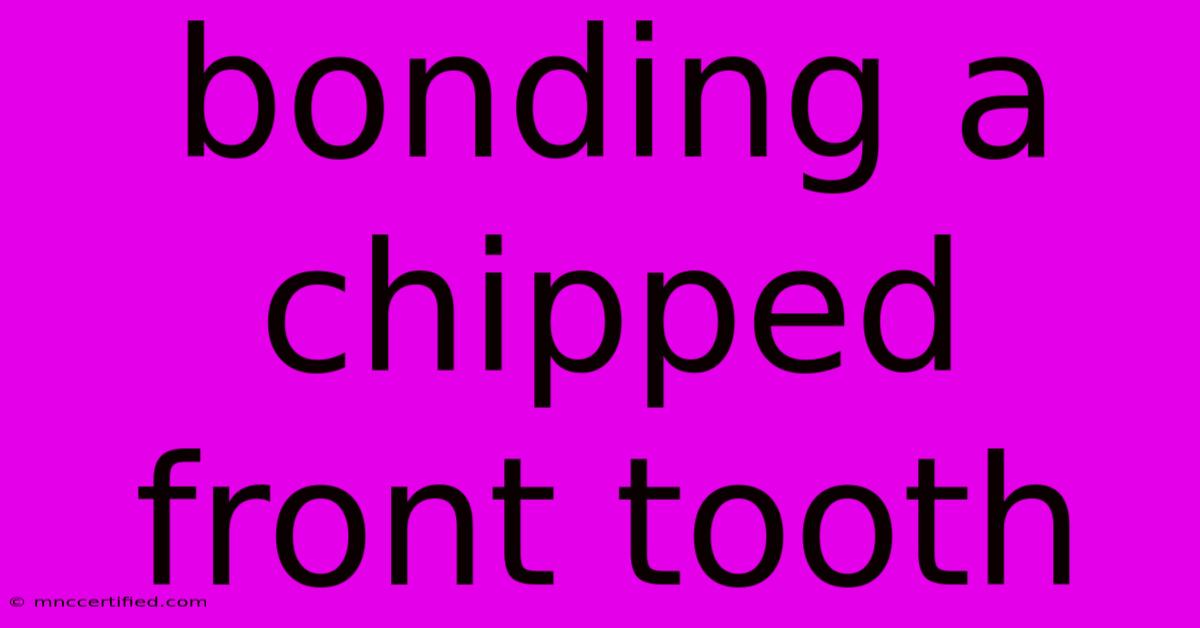Bonding A Chipped Front Tooth

Table of Contents
Bonding a Chipped Front Tooth: A Complete Guide
A chipped front tooth can be a major blow to your confidence. Fortunately, dental bonding offers a quick, affordable, and effective solution to restore your smile's aesthetic appeal. This comprehensive guide will walk you through everything you need to know about bonding a chipped front tooth, from understanding the procedure to aftercare and long-term maintenance.
What is Dental Bonding?
Dental bonding is a cosmetic dental procedure that uses a tooth-colored resin material to repair chipped, cracked, or discolored teeth. The resin is carefully matched to the shade of your natural teeth for a seamless, natural-looking result. It's a minimally invasive procedure, meaning it requires little to no preparation of the tooth itself, making it a popular choice for repairing minor imperfections.
How is a Chipped Front Tooth Bonded?
The process typically involves these steps:
-
Examination and Preparation: Your dentist will examine the chipped tooth and the surrounding area to assess the extent of the damage. They will clean the tooth thoroughly to ensure proper adhesion of the bonding material.
-
Etching: A conditioning liquid is applied to the tooth's surface to create a rough texture, improving the resin's bonding strength.
-
Resin Application: The dentist carefully applies layers of tooth-colored resin to the chipped area, building it up to match the shape and contour of your natural teeth. A special curing light is used to harden each layer.
-
Shaping and Polishing: Once the resin has hardened, the dentist shapes and polishes the bonded area to create a smooth, natural-looking finish.
Benefits of Dental Bonding for a Chipped Front Tooth
- Cost-Effective: Compared to other restorative procedures like veneers or crowns, bonding is generally more affordable.
- Minimally Invasive: It doesn't require extensive tooth preparation, preserving more of your natural tooth structure.
- Quick Procedure: The entire process can often be completed in a single appointment.
- Natural-Looking Results: The resin can be precisely matched to the color of your teeth, resulting in a seamless and aesthetically pleasing repair.
- Versatile: Bonding can be used to address various cosmetic imperfections, including chips, cracks, discoloration, and gaps between teeth.
What to Expect After the Procedure
Following the bonding procedure, you might experience some temporary sensitivity to temperature changes. This usually subsides within a few days. Your dentist will provide specific aftercare instructions, but generally, you should:
- Avoid hard, sticky, or crunchy foods: These could damage the newly bonded resin.
- Maintain good oral hygiene: Brush and floss gently, as instructed by your dentist.
- Avoid smoking and excessive caffeine consumption: These can stain the bonding material over time.
How Long Does Dental Bonding Last?
The longevity of dental bonding depends on several factors, including the size of the repair, your oral hygiene habits, and the location of the chip. With proper care, dental bonding can last for several years, but it's important to schedule regular checkups with your dentist to monitor its condition. Repairs may be needed over time due to wear and tear.
Alternatives to Dental Bonding
While bonding is a great option for many, other treatments might be more suitable depending on the severity of the chip:
- Veneers: These are thin shells of porcelain that are permanently bonded to the front surface of the teeth. Veneers are a more durable solution than bonding but are also more expensive and invasive.
- Crowns: Crowns are caps that cover the entire tooth. They're used for more extensive damage that bonding can't effectively address.
Finding the Right Dentist
Choosing a qualified and experienced cosmetic dentist is crucial for achieving optimal results. Look for dentists specializing in cosmetic dentistry and review online patient testimonials to gauge their expertise and patient satisfaction.
Keywords: chipped front tooth, dental bonding, cosmetic dentistry, tooth repair, resin bonding, chipped tooth repair, fixing a chipped tooth, bonding procedure, dental bonding cost, aftercare bonding, alternatives to bonding, veneers, crowns.
This comprehensive article covers the topic thoroughly, using relevant keywords naturally throughout the text, and employing a clear and readable structure to enhance its SEO performance and user experience. Remember to build backlinks to this article from other relevant websites to further boost its ranking in search engine results.

Thank you for visiting our website wich cover about Bonding A Chipped Front Tooth. We hope the information provided has been useful to you. Feel free to contact us if you have any questions or need further assistance. See you next time and dont miss to bookmark.
Featured Posts
-
American Dream Trading Discord
Nov 28, 2024
-
Disney Pin Trading Starter Set
Nov 28, 2024
-
Bond No 9 Sutton Place Sample
Nov 28, 2024
-
Tim Walter Short Hull City Reign Ends
Nov 28, 2024
-
Aston Villa 0 0 Juventus Goalless Draw
Nov 28, 2024